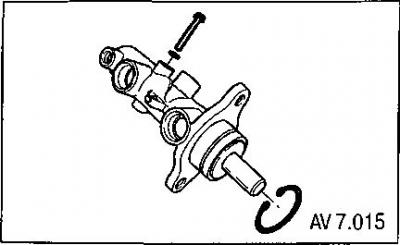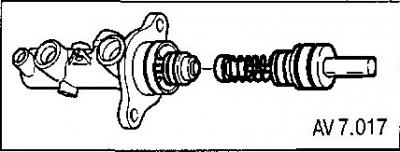Disassembly
1. Remove the main brake cylinder.
2. Remove the brake fluid reservoir.
3. Remove the O-ring from the cylinder cavity.

Attention: a rod or similar tool can be used in the compensation hole to hold the piston depressed.
4. Using a screwdriver, remove the circlip from the cylinder body. (The figure shows the brake master cylinder housing for brakes without anti-lock braking system.)
Note: When removing the circlip, be careful not to damage the piston or cylinder walls.

5. Remove the primary piston. (The figure shows the brake master cylinder housing with an anti-lock brake system.)
6. Carefully remove the secondary piston assembly and spring from the cavity of the master brake cylinder.

Assembly
Note: Do not use abrasives to clean the brake master cylinder.
Attention: rubber parts and retaining rings must be replaced with new ones.
1. Use denatured alcohol or clean brake fluid to flush all parts. Then dry these parts with compressed air.
2. Examine a cavity of the main brake cylinder regarding existence of development or corrosion. At detection of traces of development or corrosion replace the case of the main brake cylinder.
3. Lubricate the cavity of the master brake cylinder with clean brake fluid. (The figure shows the brake master cylinder for brakes without anti-lock braking system.)
4. Carefully insert the secondary piston assembly into the cavity until the secondary piston touches the base, the cylinder body. If necessary, use a wooden or plastic rod.
5. Insert the primary piston.
6. Using a wooden or plastic beard, press the pistons into the cylinder cavity.
Note: When installing a new circlip, take care not to damage the cylinder bore.
7. Insert a new circlip into the groove in the cylinder cavity. (The illustration shows the brake master cylinder housing for a brake without anti-lock braking system.) Remove the rod.
8. After installation, to check the free movement of the piston, move it back and forth.
9. Lubricate the O-ring and install the seal on the shaft in the cylinder cavity. The open side must be turned outward until the seal is firmly seated on the piston.
10. Install the brake fluid reservoir on the master cylinder.
11. Establish the main brake cylinder.
12. Raise and secure the vehicle.
13. Bleed the brake system.
14. Lower the car.
